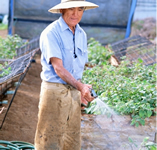
 |
|||
NIOSH Safety and Health Topic:Hazards to Outdoor Workers: UV Radiation |
|



Photos courtesy of the U.S. Fish and Wildlife Service
Ultraviolet (UV) rays are a part of sunlight that is an invisible form of radiation. UV rays can penetrate and change the structure of skin cells. There are three types of UV rays: ultraviolet A (UVA), ultraviolet B (UVB), and ultraviolet C (UVC). UVA is the most abundant source of solar radiation at the earth's surface and penetrates beyond the top layer of human skin. Scientists believe that UVA radiation can cause damage to connective tissue and increase a person's risk for developing skin cancer. UVB rays penetrate less deeply into skin, but can still cause some forms of skin cancer. Natural UVC rays do not pose a risk to workers because they are absorbed by the Earth's atmosphere.
Sunlight exposure is highest during the summer and between 10:00 a.m. and 4:00 p.m. Working outdoors during these times increases the chances of getting sunburned. Snow and light-colored sand reflect UV light and increase the risk of sunburn. At work sites with these conditions, UV rays may reach workers' exposed skin from both above and below. Workers are at risk of UV radiation even on cloudy days. Many drugs increase sensitivity to sunlight and the risk of getting sunburn. Some common ones include thiazides, diuretics, tetracycline, doxycycline, sulfa antibiotics, and nonsteroidal anti-inflammatory drugs, such as ibuprofen.
Workers at increased risk of UV damage include lifeguards, construction workers, agricultural workers, landscapers, gardeners, and other outdoor workers.
Sunburn is an often painful sign of skin damage from spending too much time outdoors without wearing a protective sunscreen. Years of overexposure to the sun lead to premature wrinkling, aging of the skin, age spots, and an increased risk of skin cancer. In addition to the skin, eyes can get burned from sun exposure. Sunburned eyes become red, dry, and painful, and feel gritty. Chronic exposure of eyes to sunlight may cause pterygium (tissue growth that leads to blindness), cataracts, and perhaps macular degeneration, a leading cause of blindness.
Unlike a thermal burn, sunburn is not immediately apparent. Symptoms usually start about 4 hours after sun exposure, worsen in 24-36 hours, and resolve in 3-5 days.
Symptoms may include:
The pain from sunburn is worse 6-48 hours after sun exposure. Skin peeling usually begins 3-8 days after exposure.
There is no quick cure for minor sunburn:
If blistering occurs:
Basal Cell
Squamous Cell
Melanoma
Changes in the size, shape, or color of moles.

In particular, watch for:
Employers should take the following steps to protect workers from exposure to UV radiation:
Workers should follow these recommendations to protect themselves from UV damage:
CDC: Traveler's Health Yellow Book Non-Infectious Risks During Travel - Sunburn
CDC: Skin Cancer Home Page
CDC provides leadership for nationwide efforts to reduce illness and death caused by skin cancer.
CDC: Skin Cancer - Questions and Answers
Occupational Safety & Health Administration (OSHA): Sawmill eTool - UV Radiation
Effects of UV radiation, controls, and solutions.
External link: http://www.occupationalhazards.com/Issue/Article/76091
/Dont_Leave_Safety_Out_in_the_Cold.aspx
OSHA: Protecting Yourself In the Sun
Information on protecting yourself from skin cancer.
External link: http://www.occupationalhazards.com/Issue/Article/76091
/Dont_Leave_Safety_Out_in_the_Cold.aspx
Environmental Protection Agency (EPA): A Guide to the UV Index![]() 1.22 MB (8 pages)
1.22 MB (8 pages)
EPA: UV Safety - The Global Solar Ultraviolet Index
UV Index flyer.![]() 108.18 KB (1 page)
108.18 KB (1 page)
EPA: Sunscreen - The Burning Facts
Information on UV rays and sunscreen.![]() 342.01 KB (6 pages)
342.01 KB (6 pages)
EPA: Prevent Eye Damage - Protect Yourself from UV Radiation![]() 155.25 KB (2 pages)
155.25 KB (2 pages)
American Academy of Dermatology: Skin Cancer
External link: http://www.aad.org/public/publications/pamphlets/sun_skin.html
American Conference of Governmental Industrial Hygienists: Product Store - Threshold Limit Values and Biological Exposure Indices
This document is available for purchase at: http://www.acgih.org/store/ProductDetail.cfm?id=1359
California Department of Public Health: Skin Cancer Prevention Program - Outdoor Workers
Includes downloadable posters, fact sheets, and quizzes.
External link: http://www.dhs.ca.gov/ps/cdic/skin/skin_resources.htm#6
Iowa State University Extension: Safe Farm - Remember Sun Safety in the Field
![]() 93.13 KB (2 pages)
93.13 KB (2 pages)
Laborer's Health & Safety Fund of North America (LHSFNA): Prepare for Summer Construction Season with LHSFNA Sun Sense Campaign
External link: http://www.lhsfna.org/index.cfm?objectID=F471D736-D56F-E6FA-95A7E0456494B9F5
National Council on Skin Cancer Prevention: Don't Get Burned on the Job Poster![]() 210.90 KB (1 page)
210.90 KB (1 page)
National Council on Skin Cancer Prevention: Fact Sheets - Skin Cancer Resources, The Basics on Sunscreens, Skin Cancer Prevention Tips![]() 61.75 KB (3 pages)
61.75 KB (3 pages)
New Mexico State University - Cooperative Extension Service: Skin Cancer![]() 63.73 KB (4 pages)
63.73 KB (4 pages)
Skin Cancer Foundation
External link: http://www.skincancer.org/
State of New Mexico Workers' Compensation Administration - Safety Facts: Working Outdoors![]() 35.70 KB (3 pages)
35.70 KB (3 pages)